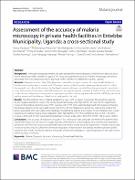| dc.description.abstract | Although microscopy remains the gold standard for malaria diagnosis, little is known about its accu‑
racy in the private health facilities in Uganda. This study evaluated the accuracy of malaria microscopy, and factors
associated with inaccurate smear results at private health facilities in Entebbe Municipality, Uganda.
Between April and May 2018, all patients referred for a malaria smear in 16 private health facilities in
Entebbe municipality were screened, and 321 patients were enrolled. A questionnaire was administered to collect
demographic and clinical information, facility-based smear results were recorded from the participant’s consultation
notes, and a research slide was obtained for expert microscopy during exit interview. A health facility assessment was
conducted, and information on experience in performing malaria microscopy was collected from all facility personnel
reading smears and the data was linked to the participant’s clinic visit.
The test positivity rate of malaria parasitaemia was 15.0% by expert microscopy. The sensitivity, specifc‑
ity and negative predictive value of the facility-based microscopy were high (95.8%, 90.1 and 99.2%, respectively).
However; the positive predictive value (PPV) was low with 27/73 (63%) patients diagnosed with malaria not having
the disease. Majority of the inaccurate results were from 2 of the 23 laboratory personnel reading the smears. The
factors associated with inaccurate smear readings included being read by a technician; (1) who had less than 5 years’
experience in reading malaria smears (adjusted Odds Ratio [aOR]=9.74, 95% confdence interval [CI] (1.06–89.5),
p-value=0.04), and (2) who was examining less than 5 smears a day (aOR=38.8, 95% CI 9.65–156, p-value<0.001).
The accuracy of malaria microscopy in this setting was high, although one third of the patients diag‑
nosed with malaria did not have the disease. Majority of the errors in smear readings were made by two laboratory
personnel, with the main factor associated with inaccurate smear results being low experience in malaria microscopy.
In-service training may be sufcient to eliminate inaccurate smear results in this setting, and these private facilities
would be ideal model facilities to improve the quality of malaria microscopy in Uganda especially in the public sector
where accuracy is still poor | en_US |


